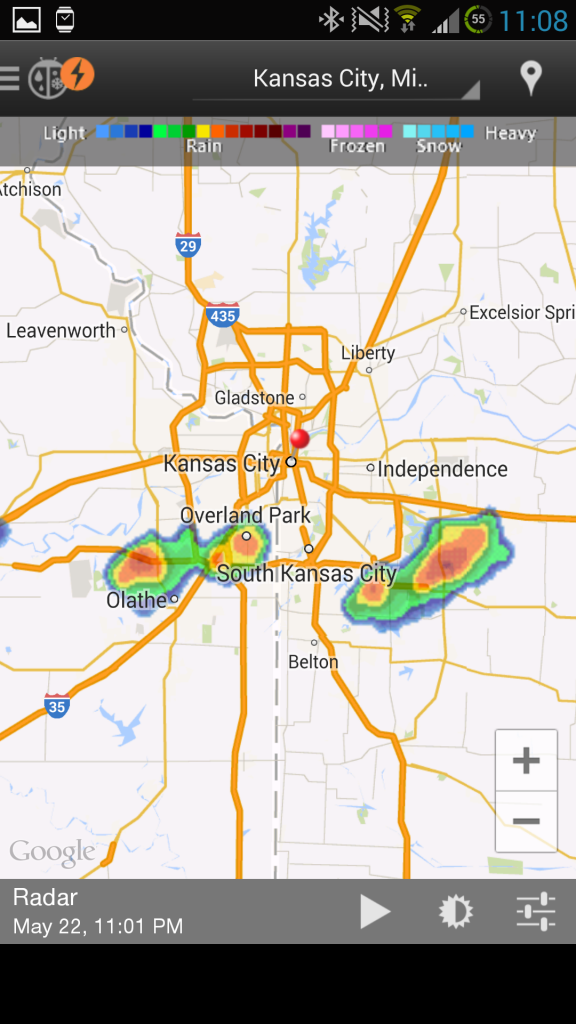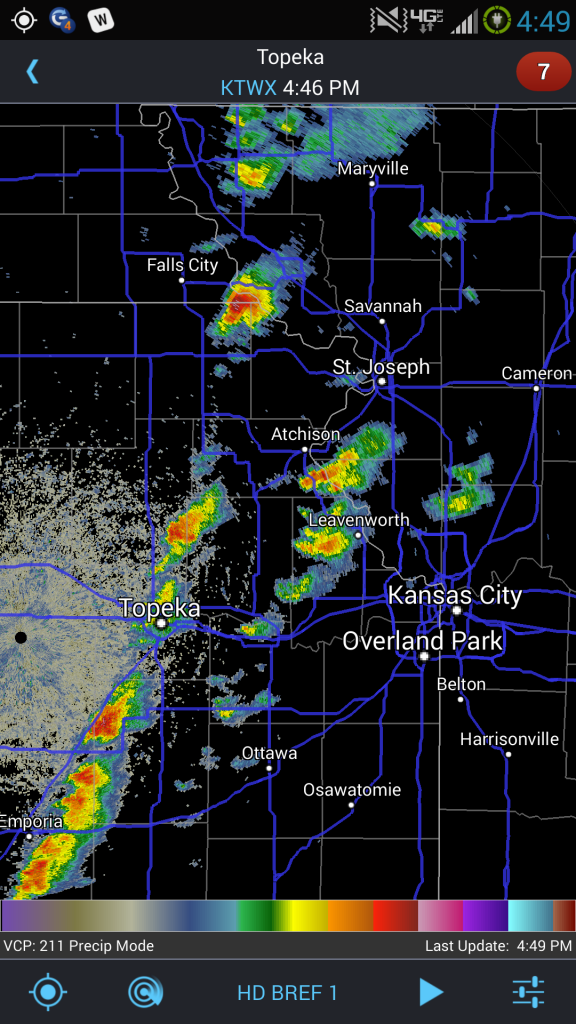Storm Tracking Technology: Meteorologist JD Rudd Shares Weather & Tech Tips
This is a guest post from JD Rudd, a life-long technology junkie who happens to be a television meteorologist in Kansas City. He enjoys reading up on the latest trends in tech and tinkering with new gadgets. Rebuilding computers and finding new ways to use electronics are some of his hobbies. When he’s not doing that, his eyes are to the sky (or on the computer forecast models) tracking incoming weather. You may remember him from our meet the blogger series. Follow JD and his weather updates on Twitter (@JDRudd) and on Facebook at www.facebook.com/KSHBJDRudd.
It’s 6:15 a.m., and your alarm goes off. After hitting the snooze button once or twice, you pick up your smartphone to see what you missed overnight and what you have to look forward to during the day. Living in the Midwest, you may swipe over to your favorite weather app to catch a glimpse of the forecast.
Uh-oh, a chance of thunderstorms today. You tap the radar button on the app. Looks like the storms are already developing. Better make sure notifications are on; it could be a long day. Is anyone talking about threatening weather on social media? Go check...
For a few minutes, our days are almost exactly the same. From the comfort of our bed and pajamas, we can get an idea of the weather in seconds thanks to storm tracking technology. A decade ago, you really only had two ways to look at the radar: watch the morning TV news or jump on the Internet and look. Fifteen years ago, the only option you had was to wait for the local TV weatherman to tell you what the radar was showing (well, or you could step outside). It used to be that I, the meteorologist, was the only one with breaking weather news. Now, in the palm of your hand, you have it quickly and easily, too.
Think for a second about how technology today has impacted you when it comes to weather. Remember the days of the old tornado sirens going off? For many, that was about the only way you knew bad weather was happening. Now, thanks to smartphones and tablets, you can get a notification from a variety of apps and text messaging services to alert you to bad weather - hours before it impacts you directly. We now have multiple ways to get the information as it’s happening.
Just recently, I was able to live stream our radar and storm coverage via our website and mobile phone app to thousands of people at the Kansas Speedway for a NASCAR race. They truly had live television in the palm of their hands!
Right now, there are hundreds of weather apps on the market, all giving you forecasts, radar, alerts and so much more. With my job, an app like RadarScope is one of the best. It gives me access to high resolution radar with several layers that are very important for tracking storms.
I’m also a fan of the Samsung Galaxy S4, which has a built-in barometer and thermometer, making your phone like a walking weather station! I use my device and my tablet every single day, and just like you, I want to know what the radar looks like. But for me, it doesn’t stop there…
Recently, during a minor severe weather day, I was out storm chasing. I was using my tablet to watch the radar (and analyze the potential for rotation in those storms) while using my smartphone to communicate data to and from the National Weather Service, through a chat room interface. Not long after, I was able to do a live TV report from my location thanks to mobile technology from Verizon. We have specialized backpack remote TV transmitters (called TVUs) that utilize multiple cell phone signals to send our live video back to the station.
So there I was, chasing a thunderstorm (something that has been occurring on this planet for thousands of years), reporting on my findings with the latest in storm tracking technology all from the front seat of a Sedan. That’s impressive!
This technology has impressed me most by making weather reporting a two-way street. Now I can communicate with people in the path of a storm directly, through apps like Facebook and Twitter, thanks to the devices I carry with me all the time. I can even see storm damage pictures and video seconds after they happen, giving me a better understanding of the weather and allowing me to relay important severe weather messages quickly and in real-time.
As you climb into bed tonight, set that alarm, and start checking your phone. I’ll be doing the same. We’ll both be keeping eyes on the weather because it will impact us both. And now instead of just being caught up in the weather, we can share, discuss and learn about the weather together. All thanks to technology that fits right there in your hand.
Do you have a favorite weather app or other storm tracking technology? Share in the comments.
For more Verizon Wireless news, subscribe via RSS feeds in the right rail.

